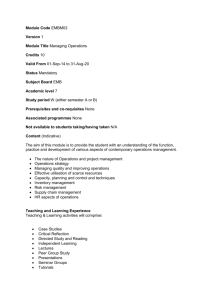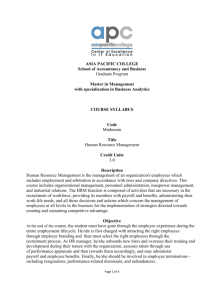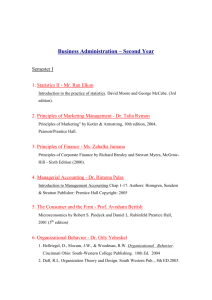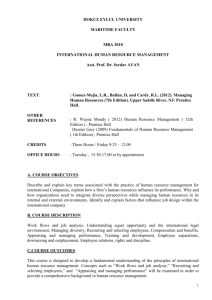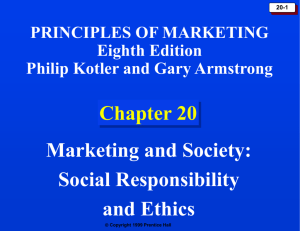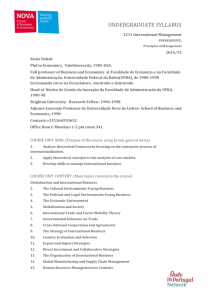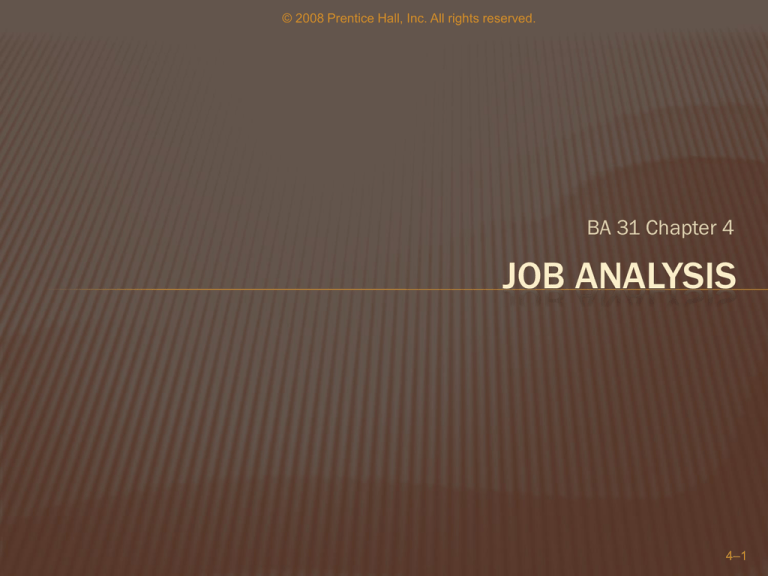
© 2008 Prentice Hall, Inc. All rights reserved.
BA 31 Chapter 4
JOB ANALYSIS
4–1
© 2008 Prentice Hall, Inc. All rights
reserved.
AFTER STUDYING THIS CHAPTER, YOU SHOULD BE ABLE
TO:
1.
Discuss the nature of job analysis, including what it is
and how it’s used.
2.
Use at least three methods of collecting job analysis
information, including interviews, questionnaires, and
observation.
3.
Write job descriptions, including summaries and job
functions, using the Internet and traditional methods.
4.
Write job specifications using the Internet as well as your
judgment.
5.
Explain job analysis in a “jobless” world, including what it
means and how it’s done in practice.
4–2
KEEPING YOU
FROM HIRING
NIGHTMARES!
© 2008 Prentice Hall, Inc. All rights reserved.
4–4
© 2008 Prentice Hall, Inc. All rights reserved.
TYPES OF INFORMATION COLLECTED
Work
activities
Human
requirements
Job
context
Information
Collected Via
Job Analysis
Human
behaviors
Machines, tools,
equipment, and
work aids
Performance
standards
4–5
© 2008 Prentice Hall, Inc. All rights reserved.
USE OF JOB ANALYSIS INFORMATION
Recruitment and
Selection
EEO
Compliance
Discovering
Unassigned
Duties
Compensation
Information
Collected Via
Job Analysis
Performance
Appraisal
Training
4–6
© 2008 Prentice Hall, Inc. All rights reserved.
FIGURE 4–1
USES OF JOB ANALYSIS INFORMATION
4–7
© 2008 Prentice Hall, Inc. All rights reserved.
JOB ANALYSIS…
(SOC) - Standard Occupational Classification
4–8
© 2008 Prentice Hall, Inc. All rights reserved.
STEPS IN JOB
ANALYSIS
Steps in doing a job analysis:
1
Decide how you’ll use the information.
2
Review relevant background information.
3
Select representative positions.
4
Actually analyze the job.
5
Verify the job analysis information.
6
Develop a job description and job specification.
4–9
© 2008 Prentice Hall, Inc. All rights reserved.
METHODS OF COLLECTING JOB ANALYSIS
INFORMATION: THE INTERVIEW
Information Sources
Interview Formats
Individual employees
Structured (Checklist)
Groups of employees
Unstructured
Supervisors with knowledge
of the job
Advantages
Quick, direct way to find
overlooked information
Disadvantages
Distorted information
4–10
© 2008 Prentice Hall, Inc. All rights reserved.
FIGURE 4–3
JOB ANALYSIS QUESTIONNAIRE FOR
DEVELOPING JOB DESCRIPTIONS
Note: Use a questionnaire like this to interview
job incumbents, or have them fill it out.
Source: www.hr.blr.com. Reprinted with
permission of the publisher, Business and Legal
Reports, Inc., Old Saybrook, CT © 2004.
4–11
© 2008 Prentice Hall, Inc. All rights reserved.
FIGURE 4–3
JOB ANALYSIS QUESTIONNAIRE
FOR DEVELOPING JOB
DESCRIPTIONS (CONT’D)
Note: Use a questionnaire like this to interview
job incumbents, or have them fill it out.
Note: Have incumbent journal their
daily duties for at least two to three
weeks. Have them bring their typed
notes or filled out forms to the
meeting.
Source: www.hr.blr.com. Reprinted with
permission of the publisher, Business and Legal
Reports, Inc., Old Saybrook, CT © 2004.
4–12
© 2008 Prentice Hall, Inc. All rights
reserved.
JOB ANALYSIS: INTERVIEWING GUIDELINES
The job analyst and supervisor should work together to identify
the workers who know the job best.
Quickly establish rapport with the interviewee.
Follow a structured guide or checklist, one that lists openended questions and provides space for answers.
Ask the worker to list his or her duties in order of importance
and frequency of occurrence.
After completing the interview, review and verify the data.
4–13
© 2008 Prentice Hall, Inc. All rights reserved.
METHODS OF COLLECTING JOB ANALYSIS
INFORMATION: QUESTIONNAIRES
Information Source
Have employees fill out
questionnaires to describe
their job-related duties and
responsibilities
Questionnaire Formats
Structured checklists
Open-ended questions
Advantages
Quick and efficient way to
gather information from
large numbers of employees
Disadvantages
Expense and time
consumed in preparing and
testing the questionnaire
4–14
© 2008 Prentice Hall, Inc. All rights reserved.
METHODS OF COLLECTING JOB ANALYSIS
INFORMATION: OBSERVATION
Information Source
Observing and noting the
physical activities of
employees as they go about
their jobs
Advantages
Provides first-hand
information
Reduces distortion of
information
Disadvantages
Time consuming
Difficulty in capturing entire
job cycle
Of little use if job involves a
high level of mental activity
4–15
© 2008 Prentice Hall, Inc. All rights reserved.
METHODS OF COLLECTING JOB ANALYSIS
INFORMATION: PARTICIPANT DIARY/LOGS
Information Source
Workers keep a
chronological diary/ log of
what they do and the time
spent on each activity
Advantages
Produces a more complete
picture of the job
Employee participation
Disadvantages
Distortion of information
Depends upon employees to
accurately recall their
activities
4–16
© 2008 Prentice Hall, Inc. All rights reserved.
FIGURE 4–4
EXAMPLE OF POSITION/JOB
DESCRIPTION INTENDED FOR
USE ONLINE
Source: www.ncf.edu/humanresources/documents/
A&P%20Final.doc. Accessed May 10, 2007.
4–17
© 2008 Prentice Hall, Inc. All rights reserved.
FIGURE 4–4
EXAMPLE OF POSITION/JOB
DESCRIPTION INTENDED
FOR USE ONLINE (CONT’D)
Source: www.ncf.edu/humanresources/documents/
A&P%20Final.doc. Accessed May 10, 2007.
4–18
© 2008 Prentice Hall, Inc. All rights reserved.
FIGURE 4–4
EXAMPLE OF POSITION/JOB
DESCRIPTION INTENDED FOR
USE ONLINE (CONT’D)
Source: www.ncf.edu/humanresources/documents/
A&P%20Final.doc. Accessed May 10, 2007.
4–19
© 2008 Prentice Hall, Inc. All rights
reserved.
COMPETENCY-BASED JOB ANALYSIS
Competencies
Demonstrable characteristics of a person that enable
performance of a job.
Reasons for Competency-Based Job Analysis
To support a high-performance work system.
To create strategically-focused job descriptions.
To support the performance management process in
fostering, measuring, and rewarding:
General
competencies
Leadership competencies
Technical competencies
4–20
© 2008 Prentice Hall, Inc. All rights reserved.
JOB SPECIFICATIONS….
4–21
© 2008 Prentice Hall, Inc. All rights
reserved.
WRITING JOB SPECIFICATIONS
Steps in the Statistical Approach
***Analyze the job and decide how to measure job
performance.
***Select personal traits that you believe should
predict successful performance.
Test candidates for these traits.
Measure the candidates’ subsequent job performance.
Statistically analyze the relationship between the
human traits and job performance.
***NOTE: We are dealing with the first two only at this point.
4–22
© 2008 Prentice Hall, Inc. All rights reserved.
WRITING JOB SPECIFICATIONS
“What traits and
experience are required
to do this job well?”
Specifications for
Trained Versus
Untrained
Personnel
Specifications
Based on
Judgment
Specifications
Based on
Statistical
Analysis
4–23
© 2008 Prentice Hall, Inc. All rights reserved.
DEFINING YOUR CORPORATE CULTURE…..
4–24
© 2008 Prentice Hall, Inc. All rights reserved.
THE DISNEY LOOK….
The Disney Look
4–25
EXAMPLES OF PERSONAL TRAITS
Organized
Self-Starters
Positive/Friendly
Personality
Teachable
Coachable
Attention to detail
Type A personality
Type B personality
Responsive
Motivated
4–26
© 2008 Prentice Hall, Inc. All rights reserved.
EMPLOYMENT PERSONALITY TESTS
4–27
© 2008 Prentice Hall, Inc. All rights reserved.
The EEOC does not validate pre-employment assessments nor
does the Office of Federal Contract Compliance. As far as
employment assessments are concerned, the extent of their
authority is to audit or investigate unacceptable procedures
when a discrimination charge has resulted from adverse
impact. Their investigation pertains to all employee selection
procedures. There have been very few disparate impact cases
involving pre-employment assessments because those
assessments generally do not have an adverse impact on any
protected group. That does not preclude misuse of an
employment assessment by requiring unreasonably high or
restrictive standards that would not be a bona fide
occupational qualification.
http://www.employment-testing.com/legality.htm
4–28
© 2008 Prentice Hall, Inc. All rights reserved.
WORKING CONDITIONS: OSHA ISSUES?
Extreme weather
conditions
Hazmat Environment
Noise (Airport)
Confined Spaces
Extreme Altitudes
Asthmatic conditions
Woodworking (Shavings)
Heavily perfumed areas
animal dander (allergy)
4–29
© 2008 Prentice Hall, Inc. All rights reserved.
JOB ANALYSIS IN A “JOBLESS” WORLD
Job Design:
Specialization and
Efficiency?
Job
Enlargement
Job
Rotation
Job
Enrichment
*Eliminating narrowly defined jobs.
4–30
© 2008 Prentice Hall, Inc. All rights reserved.
JOB ANALYSIS IN A “JOBLESS” WORLD (CONT’D)
Dejobbing the
Organization
Flattening the
Organization
Using SelfManaged Work
Teams
Reengineering
Business
Processes
Dejobbing - broadening the responsibilities of company’s
jobs and encouraging workers not to limit themselves to
what’s on their job descriptions is a result of the changes
taking place in business today.
4–31
© 2008 Prentice Hall, Inc. All rights reserved.
WRITING THE JOB DESCRIPTION
4–32
© 2008 Prentice Hall, Inc. All rights reserved.
WRITING JOB DESCRIPTIONS
Job
Identification
Job
Summary
Job
Specifications
Sections of a
Typical Job
Description
Working
Conditions
Standards of
Performance
Responsibilities
and Duties
Authority of the
Incumbent
4–33
© 2008 Prentice Hall, Inc. All rights reserved.
USING THE INTERNET FOR WRITING
JOB DESCRIPTIONS
O*NET™
Online
http://online.onetcenter.org/
4–34
http://www.biztrain.com/products/descriptionsnow.h
tm
© 2008 Prentice Hall, Inc. All rights reserved.
OCCUPATIONAL EMPLOYMENT AND WAGE
ESTIMATES…
http://www.bls.gov/
4–36
Metropolitan and Nonmetropolitan Area Occupational Employment and Wage Estimates
4–37
WHAT ARE OCCUPATIONAL CODES?
4–38
© 2008 Prentice Hall, Inc. All rights reserved.
TABLE 4–2
SOC MAJOR GROUPS OF JOBS – STANDARD OCCUPATIONAL CODES
11-0000
13-0000
15-0000
17-0000
Management Occupations
Business and Financial Operations Occupations
Computer and Mathematical Occupations
Architecture and Engineering Occupations
19-0000
21-0000
23-0000
25-0000
27-0000
29-0000
31-0000
Life, Physical, and Social Science Occupations
Community and Social Services Occupations
Legal Occupations
Education, Training, and Library Occupations
Arts, Design, Entertainment, Sports, and Media Occupations
Healthcare Practitioners and Technical Occupations
Healthcare Support Occupations
33-0000
35-0000
37-0000
39-0000
41-0000
43-0000
45-0000
Protective Service Occupations
Food Preparation and Serving-Related Occupations
Building and Grounds Cleaning and Maintenance Occupations
Personal Care and Service Occupations
Sales and Related Occupations
Office and Administrative Support Occupations
Farming, Fishing, and Forestry Occupations
47-0000
49-0000
51-0000
53-0000
55-0000
Construction and Extraction Occupations
Installation, Maintenance, and Repair Occupations
Production Occupations
Transportation and Material Moving Occupations
Military Specific Occupations
Note: Within these major groups are 96 minor groups, 449 broad occupations, and 821 detailed occupations.
4–39
4–40
http://www.bls.gov/oes/2007/may/oes_ca.htm#b00-0000
© 2008 Prentice Hall, Inc. All rights reserved.
FIGURE 4–9
MARKETING
MANAGER
DESCRIPTION
FROM
STANDARD
OCCUPATIONAL
CLASSIFICATION
(SOC CODE) =
(US FEDERAL
JOB
CLASSIFICATION
SYSTEM)
Source: www.bls.gov/soc/
soc_a2c1.htm. Accessed
August 17, 2007.
4–41
© 2008 Prentice Hall, Inc. All rights reserved.
MEAN AND MEDIAN – WHAT’S THE
DIFFERENCE???
4–42
© 2008 Prentice Hall, Inc. All rights reserved.
4–43
© 2008 Prentice Hall, Inc. All rights reserved.
Median Mean – What’s the Difference?
By understanding the difference between median and mean, and
what the implications are of each, you will be able to challenge
such assertions and avoid being duped yourself. First, a brief
explanation of each, then some real life examples of median and
mean that we can all relate to.
Let’s take this set of 11 numbers:
2 3 3 4 7 9 11 12 14 17 25
The median and the mean are pretty close together, but different
nonetheless. See the attached Excel-generated output:
4–44
© 2008 Prentice Hall, Inc. All rights reserved.
WAGE RANGE:
Wage Range
The relative standard error (RSE) is a measure of the reliability of a survey
statistic. The smaller the relative standard error, the more precise the estimate.
4–45
WAGE/HOUR INFORMATION FROM DOL…
© 2008 Prentice Hall, Inc. All rights reserved.
4–46
DETERMINING THE STATUS OF THE POSITION….
4–47
© 2008 Prentice Hall, Inc. All rights reserved.
EXEMPT
http://personnel.ky.gov/NR/rdonlyres/44CAB895-3CB2-4CF4-BADD-A2EB679273A0/0/flsatest.pdf
4–48
Exempt
v. NonExempt?
FAIR LABOR
STANDARDS
ACT
http://www.flsa.
com/coverage.
html
© 2008 Prentice Hall, Inc. All rights reserved.
THE AUDIT: TEST YOUR COMPLIANCE
Test Your Compliance
http://www.nibmimages.com/nibm/Audit-TestYourCompliance.pdf
4–50
Contractor? Employee?
http://www.irs.gov/businesses/small/article/0,,id=99921,00.html
© 2008 Prentice Hall, Inc. All rights reserved.
TWO RECENT
COURT CASES
REGARDING
CLASSIFICATION
DISPUTES!
4–52
© 2008 Prentice Hall, Inc. All rights reserved.
RECAP – SUMMARY AND STEPS:
4–53
© 2008 Prentice Hall, Inc. All rights reserved.
THE JOB DESCRIPTION
SUMMARY
Job Identification
Job title
*FLSA status section –
Exempt/Non-Exempt?
Wage
Job Summary
General nature of the job
Major functions/activities
Relationships
Reports to:
Supervises:
Works with:
Outside the company:
Major Responsibilities and Duties
Major responsibilities and
duties (essential functions)
Decision-making authority
Direct supervision
Budgetary limitations
Standards of Performance and
Working Conditions
What it takes to do the job
successfully
Written Job Description
*FAIR LABOR STANDARDS ACT
4–54
© 2008 Prentice Hall, Inc. All rights
reserved.
WRITING JOB DESCRIPTIONS: STEPS
*Step 1. Decide on a Plan
*Step 2. Develop an Organization Chart
Step 3. Use a Job Analysis/Description Questionnaire
(Done)
Step 4.
Obtain Lists of Job Duties from O*NET
Step 5. Compile the Job’s Human Requirements from
O*NET – SOC code?
Step 5 Determine Wage/Hour – Exempt – Non-Exempt
Step 6. Complete Your Job Description
*Who does this person report to?
4–55

